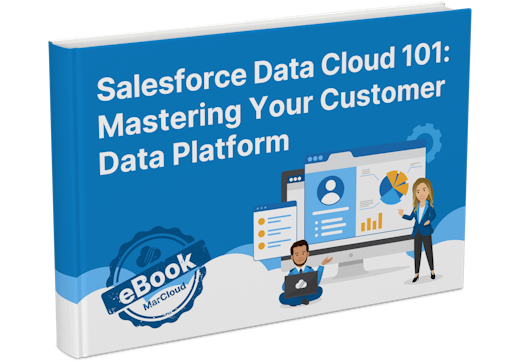Firstly, the beauty of being in the Salesforce ecosystem as a Marketing Cloud customer (whether you’re using Engagement or Account Engagement) is that integration between Salesforce products is straightforward.
Marketing Cloud and Sales Cloud integrate using Marketing Cloud Connect so if you haven’t set this up yet, there’s your first task. You’ll find a guide to Marketing Cloud Connect on our blog.
It’s also possible to use Marketing Cloud Engagement and Account Engagement together, with the right infrastructure in place.
Ideally, your Salesforce marketing automation software and CRM will be unified from the start, if your implementation has been done properly.
All that leaves then, is third-party integration with external systems.
For this, you have three options:
1. Manual data export/import
Any task with the word ‘manual’ in the title is an instant no from us, but depending on your circumstances, it might be necessary to go this route.
Firstly, as the name suggests, it involves exporting a csv. file of your data from the third-party system. Naturally, this comes with risks, including data corruption and potentially breaching GDPR compliance. Always make sure you’re managing data exports with due diligence and that teams are trained in data compliance measures.
Next, you’ll be pleased to know that Marketing Cloud Engagement comes with an FTP Site that allows you to drop files and automate the import of your data into Marketing Cloud, according to the settings you put in place.
This method takes a fair bit of setup time and resource but can go someway to unifying your customer data in Marketing Cloud with limited manual handling.
2. Building API integrations
An API integration is simply connecting two or more platforms together, via their APIs, in order for them to exchange data. You can have a one-way integration whereby data flows from one system to another, or two-way integration where the two systems send and receive data.
Marketing Cloud Engagement has a comprehensive set of APIs that allows you to read, edit, and create any asset on the platform, as well as enabling the import or export of data.
Moreover, with AMPScript and SSJS, Marketing Cloud Engagement has the native scripting capability to make calls to external APIs from any third party, which reduces the need for integration services (such as Zapier or Mulesoft).
These factors, along with inbuilt tools, such as enhanced FTP file retrieval and Automation Studio, make third-party API integrations a good option.
But you don’t necessarily need to build your own integration. Marketing Cloud Engagement comes with a bunch of out-of-the-box integrations.
To develop your own third-party integration, you’ll need the following resources:
Web developer familiar with API integrations and with a deep understanding of at least one, if not both/all, of the systems
Somebody to map which data fields and values should be imported to Marketing Cloud - best case scenario, this is a data scientist familiar with SQL queries and structuring data but at the very least, it should be a member of your team confident in creating and using Data Extensions.
The integration will need to be properly planned and built to achieve your data goals. Sometimes this is straightforward, other times it can be a complicated and lengthy process.
3. Make use of Data Cloud
Another Salesforce product, Data Cloud combines the data from multiple tools in a single place that can be used to access a unified view of the customer.
Data Cloud is an evolution of Salesforce’s CDP (Customer Data Platform) that can be positioned between all your key Salesforce platforms and any other data source you wish to use. Its core function is to help you unify your data into one comprehensive usable model which can be used to conduct coordinated sales, marketing, service, and analytics campaigns. It’s useful not only for marketing teams, but also for sales, customer service, ecommerce, and other business functions too.
Enterprise and Ultimate Sales Cloud customers have access to a free Data Cloud account at the time of writing this article.
What’s super exciting about Data Cloud is that it can connect with Salesforce and third-party systems in real-time, enabling you to be super responsive to new data on your customer and ensuring that you have a single, up-to-date view of each individual your organisation interacts with.
The capabilities of Data Cloud are massive (for example, we haven’t even talked about how you can use AI modelling!) and the opportunity to make sense of customer data in a clear and actionable way, is huge.
To put it bluntly, if your goal is to unify Marketing Cloud data with third-party tools, Data Cloud is your best option.
Download the Salesforce Data Cloud 101 eBook for a full guide and expert tips for getting started. For personalised support unifying your Marketing Cloud data, you can contact the MarCloud team any time.






